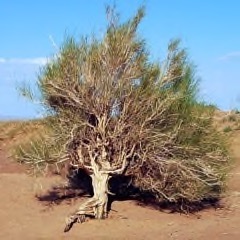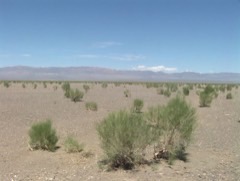 |
|
Szerkeszt on Wikimedia.org |
 |
| Szerkeszt on Wikimedia.org |
Translate this page:
Summary
Physical Characteristics

 Haloxylon spp is an evergreen Shrub growing to 8 m (26ft) by 6 m (19ft) at a slow rate.
Haloxylon spp is an evergreen Shrub growing to 8 m (26ft) by 6 m (19ft) at a slow rate.
See above for USDA hardiness. It is hardy to UK zone 10.
Suitable for: light (sandy) and medium (loamy) soils, prefers well-drained soil and can grow in nutritionally poor soil. Suitable pH: neutral and basic (mildly alkaline) soils and can grow in very alkaline and saline soils.
It cannot grow in the shade. It prefers dry or moist soil and can tolerate drought.
UK Hardiness Map
US Hardiness Map
Synonyms
See individual species.
Plant Habitats
Edible Uses
Its bark can be pressed to extract drinkable water--a critically important commodity for nomadic peoples.
References More on Edible Uses
Medicinal Uses
Plants For A Future can not take any responsibility for any adverse effects from the use of plants. Always seek advice from a professional before using a plant medicinally.
See individual species. Roots host the parasitic plant cistanche, which traditional Asian herbalists use to produce a salty-tasting medicinal component used in treating ailments of infertility, age-related lethargy, blurred vision, memory loss, baldness, balance disorders and heart palpitations. Cistanche is sometimes known as the "ginseng of the desert."
References More on Medicinal Uses
The Bookshop: Edible Plant Books
Our Latest books on Perennial Plants For Food Forests and Permaculture Gardens in paperback or digital formats.

Edible Tropical Plants
Food Forest Plants for Hotter Conditions: 250+ Plants For Tropical Food Forests & Permaculture Gardens.
More

Edible Temperate Plants
Plants for Your Food Forest: 500 Plants for Temperate Food Forests & Permaculture Gardens.
More

More Books
PFAF have eight books available in paperback and digital formats. Browse the shop for more information.
Shop Now
Other Uses
Fodder
It provides fodder for livestock. Its wood is a good fuel. Provides cover and forage for wildlife. The wood yields a green dye used for colouring wool yarn. Carbon Farming Solutions - Fodder: bank.
Special Uses
Carbon Farming
References More on Other Uses
Cultivation details
Fodder: Bank Management: Coppice Regional Crop
Climate: cold to warm temperate. Humidity: arid to semi-arid. Haloxylon species live in harsh habitats such as moving or fixed sands, saline depressions, dry canyons, clay and rock submontane planes, rocky hill and mountain slopes and tertiary badlands. They are shrubs or small trees 1–8 metres (3–26ft) tall. The well done species are Haloxylon ammodendron (saxaul), Haloxylon aphyllum (black saxaul), and Haloxylon persicum (white saxaul). They are very important and useful native plants in the arid region from the Caspian Sea eastward across the Gobi Desert having considerable tolerance for aridity, wind, salinity and limited nitrogen. Can grow in different soil types but the root is more successful in sandy soils rather than heavily textured soils. The succulent root system acquires more water and survives drought better in sandy soils providing good anchorage in strong winds. In good conditions with some available water small forests appear. Carbon Farming Solutions - Cultivation: regional crop. Management: coppice (Describes the non-destructive management systems that are used in cultivation) [1-1].
Carbon Farming
-
Fodder: Bank
Fodder banks are plantings of high-quality fodder species. Their goal is to maintain healthy productive animals. They can be utilized all year, but are designed to bridge the forage scarcity of annual dry seasons. Fodder bank plants are usually trees or shrubs, and often legumes. The relatively deep roots of these woody perennials allow them to reach soil nutrients and moisture not available to grasses and herbaceous plants.
-
Management: Coppice
Cut to the ground repeatedly - resprouting vigorously. Non-destructive management systems maintaining the soil organic carbon.
-
Regional Crop
These crops have been domesticated and cultivated regionally but have not been adopted elsewhere and are typically not traded globally, Examples in this broad category include perennial cottons and many nuts and staple fruits.
References Carbon Farming Information and Carbon Sequestration Information
Temperature Converter
Type a value in the Celsius field to convert the value to Fahrenheit:
Fahrenheit:
The PFAF Bookshop
Plants For A Future have a number of books available in paperback and digital form. Book titles include Edible Plants, Edible Perennials, Edible Trees,Edible Shrubs, Woodland Gardening, and Temperate Food Forest Plants. Our new book is Food Forest Plants For Hotter Conditions (Tropical and Sub-Tropical).
Shop Now
Plant Propagation
See individual plant entries.
Other Names
If available other names are mentioned here
Haloxylon spp. Haloxylon species. Saxaul, Sacsaoul, Saksaul, C?????i?, Seksewil
Native Range
Coming Soon
Weed Potential
Right plant wrong place. We are currently updating this section.
Please note that a plant may be invasive in one area but may not in your area so it's worth checking.
None Known
Conservation Status
IUCN Red List of Threatened Plants Status : This taxon has not yet been assessed

Growth: S = slow M = medium F = fast. Soil: L = light (sandy) M = medium H = heavy (clay). pH: A = acid N = neutral B = basic (alkaline). Shade: F = full shade S = semi-shade N = no shade. Moisture: D = dry M = Moist We = wet Wa = water.
Now available:
Food Forest Plants for Mediterranean Conditions
350+ Perennial Plants For Mediterranean and Drier Food Forests and Permaculture Gardens.
[Paperback and eBook]
This is the third in Plants For A Future's series of plant guides for food forests tailored to
specific climate zones. Following volumes on temperate and tropical ecosystems, this book focuses
on species suited to Mediterranean conditions—regions with hot, dry summers and cool, wet winters,
often facing the added challenge of climate change.
Read More
Expert comment
Author
Various
Botanical References
Links / References
For a list of references used on this page please go here
Readers comment
| Add a comment |
|
If you have important information about this plant that may help other users please add a comment or link below. Only comments or links that are felt to be directly relevant to a plant will be included. If you think a comment/link or information contained on this page is inaccurate or misleading we would welcome your feedback at [email protected]. If you have questions about a plant please use the Forum on this website as we do not have the resources to answer questions ourselves.
* Please note: the comments by website users are not necessarily those held by PFAF and may give misleading or inaccurate information.
To leave a comment please Register or login here All comments need to be approved so will not appear immediately.
|
|